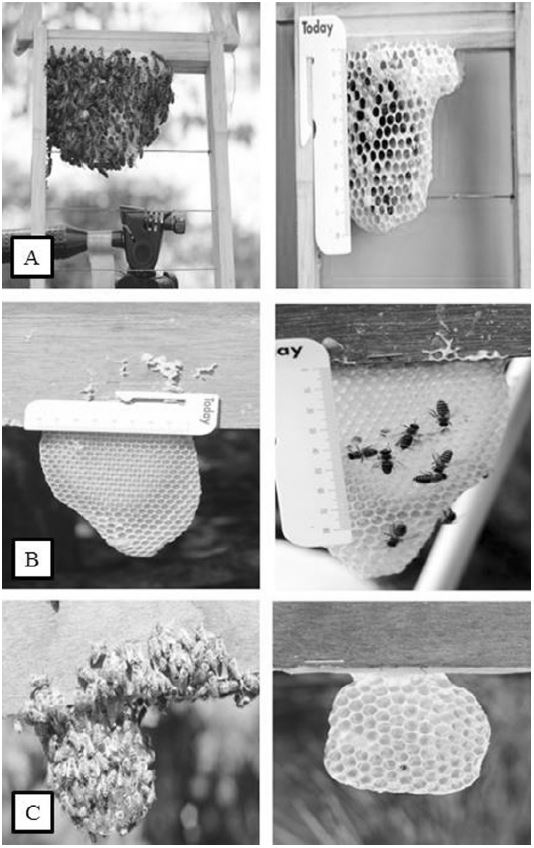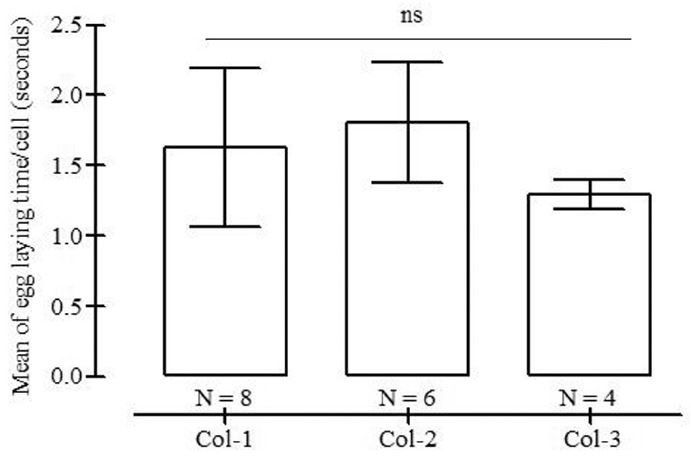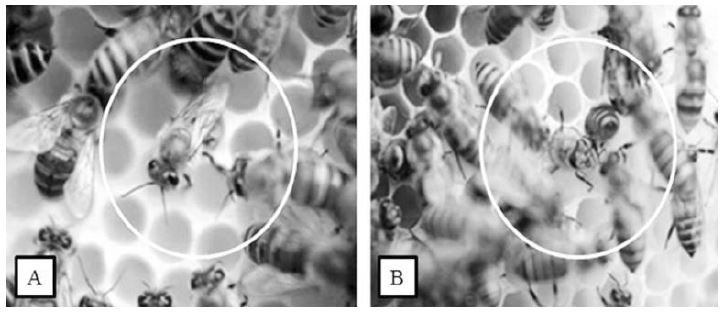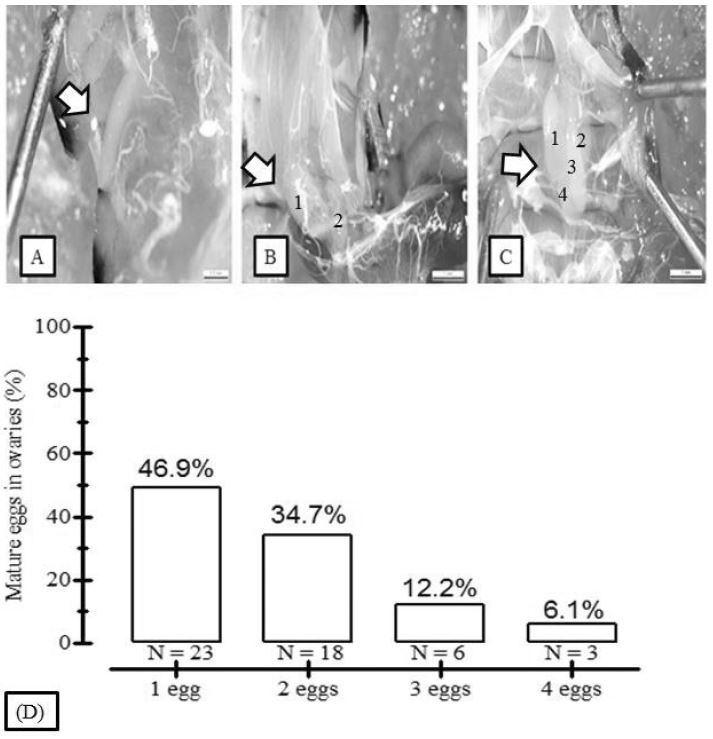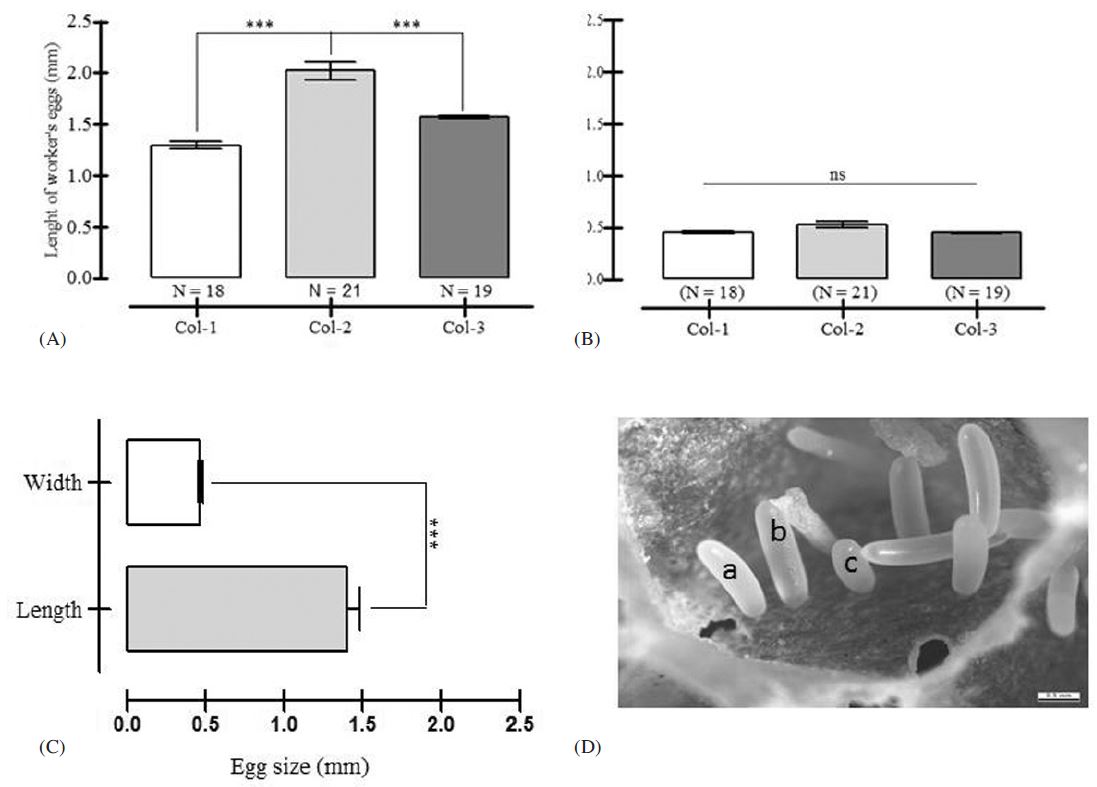
Reproductive Performance of Laying Worker of Apis cerana in Queenless Colonies
Abstract
The Asian cavity-nesting honey bee, Apis cerana, the workers ovaries is very active in queenless colonies. We investigated the duration of egg laying by laying workers, egg-laying behavior, determine egg load in ovaries, estimate oviposition rate nad number of eggs per cell in three queenless colonies of Korean A. cerana. The number of eggs laid by laying workers at different times on the manipulated comb was checked and counted. We observed that the laying workers spent, on average, 109.2 seconds per cell. During oviposition, the laying workers showed two types of behaviors, viz; a still phase, and a recovery phase. On average, 4.0 of worker eggs per cell per week was recorded. The workers laid three different shapes of eggs in a cell. The laying workers ovaries retained 1 to 4 mature eggs. This suggests that a laying worker may lay from one to four eggs per oviposition. We did not observe false-queen in Korean A. cerana in three queenless colonies. In this study, we reported for the first time that one worker cell of A. cerana retains up to 33 eggs in queenless condition. The queenless colonies build the comb and lay eggs in new comb, and also reared the new queen without successful development of the queen larva from laying worker eggs.
Keywords:
Apis cerana, Worker oviposition, Egg-laying duration, Egg-laying behavior, Korean honey beesINTRODUCTION
The Asian cavity-nesting honeybee, Apis cerana Fabricius, 1973 workers begin to lay eggs within 2-3 days after their queen lost (Blanford, 1923). About 10~20% of Japanese A. cerana cerana workers in queen dominated colonies had mature eggs in their ovaries (Sakagami and Akahira, 1958). The laying workers show an aggressive behavior during egg laying in the queenless colony (Sakagami, 1958). Likewise, 72% of Indian A. cerana indica workers activate their ovaries in queenless and broodless colonies (Bai and Reddy, 1975). During such a queenless situation, a dominant hierarchy is re-established between the workers by developing their non-functional ovaries and lay unfertilized eggs (Ruttner and Hesse, 1981; Page and Erickson, 1988; Visscher, 1989; Robinson et al., 1990; Crozier and Pamilo, 1996). Oldroyd et al.(2001) reported that 15% of Thai A. cerana workers have active ovaries 4 days after dequeening. Around 5% of workers have eggs in their ovaries (Nanork et al., 2007).
In this study we examined the reproductive performance of laying workers of Korean A. cerana. So far, there is very limited information especially on Korean A. cerana strain worker’s regarding ovipositional behavior in case of queenless colonies. Therefore, this research was done to determine Korean A. cerana worker’s duration of oviposition, egg laying behavior, egg load, and number of laying worker’s eggs per cell in queenless situation.
MATERIALS AND METHODS
Experimental colonies
Three A. cerana colonies collected from a local A. cerana beekeeper in March 2013. Colonies were maintained at the apiary, Department of Agricultural Biology, Rural Development Administration (RDA), National Academy of Agricultural Science (NAAS), Suwon (33°44' N; 12°13' E), the Republic of Korea. Three absconded and nested in nearby mulberry trees (Morus alba) colonies on 15 and 17, May were rehived in modified Korean traditional hives with moveable frames. On the 19th of May, all three colonies were found queenless. On the 25th of May, all three colonies built new small combs (average length 5.7±1.1, range 4.4~6.4cm, width 6.2±1.8, range 4.7~8.3, N=3, Fig. 1A-C), which contained worker cells with no drone and queen cells in three queenless colonies. These experimental colonies had around 500 workers in each. Sugar syrup (50% w/v) was fed until the end of the experiment. The experimental colonies were kept three meters apart under the canopy of oriental cherry trees (Prunus serrulata).
Duration of oviposition
Main question of this experiment was how long the laying worker took to lay eggs in queenless colonies. The duration of oviposition by laying works were observed in three queenless colonies in May 2013. A frame with egglaying workers was hung on a branch at the height of 70cm in the shade of a mulberry tree. Oviposition of each laying worker was individually video with a digital CANON-60D camera after abdominal insertion into the cell until it was withdrawn. We were unable to video the number eggs laid per cell since it would have disrupted the combs.
Egg laying behavior during oviposition
To determine the egg-laying behavior of workers and their behavioral interaction with other workers in the queenless colony, one frame at a time with egg-laying workers from a queenless colony was hung on a small branch at the height of 70cm in the shade during 13:30~15:00 hours at 30°C sunny day at the RDA apiary May 2013. Egg-laying behavior of each egg-laying worker was individually videoed during oviposition.
Determination of egg load in laying worker ovaries
To determine the egg load (total number of mature eggs retained in the ovaries) in laying workers. A frame with laying workers were put under the shade of P. serrulata, and the laying workers were immediately collected after inserting of laying worker abdomen into the cell in June 2013. In total, 49 laying workers from four queenless colonies were chilled at -10°C for 30 minutes and freshly dissected under the stereomicroscope to assess the egg load per laying worker. The gut was gently removed with a fine tip forceps and then, the number of matured eggs was counted, however, the developing oocytes were not taken into account.
Oviposition rates
This experiment was conducted on a small comb (4.5×6.5cm, Fig. 1C) in one queenless colony for 16 days after dequeening in September 2013. To estimate the number of eggs laid by laying workers, eggs deposited in a natural comb were collected at 24, 53, 74, 120 and 171 hours. In each count, all the worker eggs were cleaned with wet cotton buds and gave to the same queenless colony. The number of eggs per cell was randomly counted and photographed. This experiment was repeated three times.
Estimation of the number of eggs per cell per week after manipulation combs
To estimate the number of eggs per cell, a new comb (10×14cm; Fig. 1B) was attached at the bottom of a feeder and squeezed between the two old combs containing honey, and pollen but no brood. The oviposition comb was collected weekly, and the number of eggs deposited in a cell was randomly counted under the Leica stereomicroscope(MZ16-A). After counting the number of eggs, each cell was cleaned with wet cotton buds and squeezed again between two frames. This experiment was done in one queenless colony.
Measurement of laying worker egg size
The freshly laid eggs (less than 1 day) were collected from three different queenless colonies. Worker laying egg comb frames with empty worker cells were chosen and checked carefully under the Leica stereomicroscope and cleaned with cotton buds to make sure that there were no previous eggs on it. The frames (N=3) were placed back into the same queenless colonies. The worker eggs were removed by cutting the cell with a razor to remove the egg easily without any damaging the eggs. The laying workers’ eggs were measured by removing the cell walls of each cell and then the eggs were put on a glass slide. The size of egg of laying worker was calculated (Preston, 1968; Hoyt, 1979).
Data analysis
Analysis of variance (one-way ANOVA) was performed to evaluate the duration of oviposition in three different queenless colonies, eggs load in the ovaries of laying workers, and ovipostion rate at different hours (24, 53, 74, 120 and 171 hrs) and weekly, and the multiple significant was compared with a Tukey post-hoc. The egg laying rate between summer and Autumun season laying workers were compare by using independent t-test. The significant value was reported at 0.05 level.
RESULT
Duration of egg oviposition
The average times spent by a laying workers was 109.2 ±67.5 seconds per cell (range 34-324 seconds, Nobservation = 19 laying workers). The duration of oviposition in the three colonies (colony-1: 113.6±87.3 seconds per cell, range 34-324 seconds, N=9, colony-2: 117.2±58.5 seconds per cell, range 54-194 seconds, N=6, and colony-3: 87.2±23.3 seconds per cell, range 60-116 second, N=4) was not significantly different in three queenless colonies (F(2,16) = 0.249, P > 0.783, Fig. 2).
Egg laying behavior
An egg-laying worker first inserted her head in several cells and then immediately inserted her abdomen as deep as up to the fore-wing level and remained motionless like a queen (Fig. 3A-B). This is termed the still phase indicating that she is laying eggs. After laying her eggs, the worker vigorously wagged her abdomen. This is termed the recovery phase and indicates that eggs have just been laid. During the recovery phase, the laying-worker slowly pulls out her abdomen and vigorously shakes, which may be caused by the great physical strain during laying time.
Estimation of egg load
The mature eggs were whitish and oval-shaped, whereas the immature eggs were not differentiated in shape inside the ovaries (Fig. 4A-C). The mean number of egg load per laying worker was 1.8±0.8 (range 1 to 4 eggs, Nlaying workers (LW) = 49). The egg load in the laying workers of four queenless colonies (colony-1: 2.0±0.9, range 1-3 eggs, NLW = 10; colony-2: 1.8±0.8, range 1-4 eggs, NLW =11; colony-3: 1.6±1.0, range 1-4 eggs, NLW=18, and colony- 4: 1.8± 0.6, range 1-3 eggs, NLW=10) were not significantly different (F(3,45)=0.406, P>0.749) from eggs load (Fig. 4D). We observed 46.9% of egg-laying workers had one egg (Ncolony=3), 34.7% had 2 eggs (Ncolony=3), 12.2% had 3 (Ncolony=3), and 6.1% had 4 eggs (Ncolony=2) in their ovaries.
Estimation of worker oviposition rates per hours
A total of 318 cells were checked during 171 hours. On average 3.0±1.9 eggs per cell (range 1-13 eggs, Ncells=318) were recorded from a single queenless colony. The highest number of eggs number (13 eggs/cell in manipulated) was observed at 120:00 hours (Table 1). There was a significant difference in the eggs-laying rate at different hours (F(4,313)=22.663, P<0.001). A Tukey posthoc tests revealed that egg-laying rate at 24 hours (2.4± 1.4 eggs) was not significantly different when compared to 53 hours (3.2±1.3, p>0.2) and 171 hours (2.2±1.5, p>0.8), but it was significantly different when compared to 74 hours (3.4±1.6, P<0.01) and 120 hrs. (4.8±2.6, P<.001).

Egg deposition in the manipulated comb by laying workers in a queenless colony. Meteorological data, temperature (20.6± 5.8°C), relative humidity (77.8±23.7%), rain (8.3±21.4mm), solar radiation (17.8±19.8W), and light intensity (4.6±4.7 lx) were recorded during experimental times from 1st September to 29 September 2013 at A. cerana apiary, Suwon. Note: a=not significantly different, ab=significantly different.
Estimation of number of laying worker eggs per cell per week
After 7 days of dequeening, worker’s eggs were observed. On an average, 4.0±5.1 of laying worker eggs (range 0-33 eggs, Ncells= 300) were recorded per cell. The first week was 4.7±2.4 eggs (range 1-11 eggs, Ncells=54), second week 12.8±6.2 (range 2-33 eggs, Ncells=49), third week 2.3±1.2 (range - 6 eggs, Ncells=44), fourth week 4.5 ±2.0 (range 2-9 eggs, Ncells=45), and fifth week 0.2±0.4 (range 0-3 eggs, Ncells=108) was recorded in the after dequeening (Fig. 5A). The highest number of eggs (33eggs/cell, Fig. 5B) in nautral comb was counted in second week was a significantly different in the number of eggs per cell between the weeks (F(4, 295)=169.205, P<0.001). A Tukey post-hoc test revealed that the number of eggs in weeks 1, 2, 3 and 5 were significantly different (P<0.001) than week 4 (P>0.9).
Laying worker eggs size
The average length of laying workers eggs were 1.659±0.39 (N=58, Fig. 6A). The length of laying workers eggs in three queenless colonies (colony-1: 1.29±0.16 (range 1.06-1.67, N=18); colony-2: 2.02±0.40 (range 1.62-3.09; N=21); and colony-3: 1.57±0.07 (range 1.35-1.68, N=19, Fig. 6B) were statistically different (F(2)=37.744, Sig<0.001). A Turkey post-hoc tests revealed that the length of the eggs was significantly different in three queenless colonies. The average width of laying workers eggs were 0.481±0.089 (N=58). The width of laying workers eggs in three queenless colonies (colony-1: 0.456 ±0.048, range 0.40-0.54, N=18; colony-2: 0.529±0.126, range 0.41-0.76, N=21; colony-3: 0.453±0.033, range 0.38-0.53, N=19) was statistically significant (F(2)=5.532, P<0.005, Fig. 6C). A Turkey post-hoc tests revealed that the width of the eggs of colony-1 was significantly different than colony-2 but not with colony-3. Three different size of eggs were observed (Fig. 6D).
DISCUSSION
The duration of opposition of laying workers varies from worker to worker, according to the numbers of eggs in their ovaries. Our results showed that egg-laying workers of A. cerana spent 34-324 seconds per cell, which is higher than the previous report reported by Sakagami (1958), who noted 17-261 seconds A. cerana japonica. This difference might be due to subspecies of Korean A. cerana cerana. Kapil (1962) reported that mature eggs in laying-workers descend approximately at the same time. Since The reproductive organ of workers has not developed reproductive muscles of their own, the worker may retain the eggs in their ovaries for a sufficient period. As a consequence, laying workers do not enable to lay the eggs in an organized manner like a queen. The result of this muscle deficiency is that a worker lays more than one egg in a cell. Another reason is that muscles surrounded the vagina and bursal pouches anteriorly and up to the base of the sting posteriorly, which help the queen bee push the eggs forwards (Laidlaw, 1944) may lack in laying workers. Kapil (1962) has shown that laying workers of A. cerana indica has anatomically less control over ovulation than queens.
We observed that, laying worker show similar behavior like a queen, a laying worker searches for a cell to lay her eggs. This behavior suggests that laying workers do not randomly lay eggs in a cell. We also observed that sometimes an egg was attached to the last abdominal segment of the egg-laying worker. This suggests that the egg-laying workers do not destroy or knock them down the pre-exiting eggs. We did not observe egg-laying workers continually laying eggs in each cell like a queen. After laying eggs, the worker quickly moved to the other side of the comb and mixed with other workers in a cluster. We also did not observe egg-laying workers being attacked by nest-mate in three queenless colonies of A. cerana (Fig. 3A-B) as reported for A. mellifera (Visscher and Dukes, 1995). We observed in colony-3 that the egg-laying worker in the still phase (egg-laying time) kept her mandibles open. This suggests that egg-laying worker may be aggressive during the oviposition time. When the egglaying worker is in the still phase, no attendants circle her (Fig. 3A-B) like a queen as described by Sakagami (1958). This suggests that the egg-laying workers cannot produce a queen-like pheromone to attract the attendants. We observed some workers with swollen abdomens, but smaller than a queen and without attendants. Therefore, we did not consider them as false queens. Colony activity like workers in cluster, pollen and nectar collection in our queenless colonies was normal as in queened colony as described by Sakagami (1958). Our queenless colonies were aggressive to nest intruders as reported by Oldroyd et al. (2001). The most interesting behavior of our queenless colonies was that they built combs, workers engaged in egg-laying and cleaning, policing activities as the egglaying workers of A. mellifera (Ratnieks, 1988; Hillesheim et al., 1989). Our three queenless colonies did not abscond during our observations from 16th of April to 31th of September 2013. This suggests that queenless colonies are less prone to abscond, but highly prone to be robbed by strong colonies of A. mellifera. All three queenless colonies had 80% of drones produced from laying workers. At the end of October, all three queenless colonies were robbed by A. mellifera colonies nearby.
The laying worker had carried 1 to 4 mature eggs in her ovaries. This indicates that there is no circadian regulation of egg maturation in laying worker like the queen. The oviposition in laying workers did not occur with a circadian rhythm. The rhythmic removal of eggs from reproductive system requires the mature eggs are available for oviposition at circadian intervals. The time between ovulation and oviposition is often constant and quite brief may be synchronized with rhythmic ovulation. We did not observe the circadian rhythmical development of eggs in the laying worker ovaries. Subsequently, Sakagami (1958) observed 3 ripen eggs in the developing ovarioles of A. cerana japonica.
Three different sizes of eggs were laid by laying workers in queenless colonies. First, we assumed that this is due to the fact that during the egg formation, as the content of egg travels down the oviduct, and it's encased by the shell and force to out through the vent. Like in fowls, the oviducts tend to be narrow downward; as a consequence, small width eggs are laid. Second, as the laying worker grows older, the oviduct becomes wider, allowing a large and broad egg. As a consequence, egg breadth increases with age and decrease at later age due to decreasing of calcium deposition for egg shell. Finally, the different size of eggs suggests that variation among the individual is due to genetic variation. Egg size is influenced by genotype patrilines of workers (Bacon and Mountford, 1990), age (Davis, 1975), and population density (Coulson et al., 1982). Another reason may be that worker laid eggs is containing greater amounts of nutrients than queen laid eggs (Wegener et al., 2010). Woyke (1994) reported that eggs from queens are longer, but narrow compared to the laying workers' eggs in Thai A. cerana (Woyke et al., 2003). This difference may probably be due to different pressure and limitations across the distribution range of the species A. cerana.
We observed that the egg-laying rate at 24, 53 and 171 hours was low. The most plausible explanation is that when we gave a new comb from a different queen-right colony, the workers of queenless colony did not lay eggs in the central part of the comb. This is probably due to the presence of queen pheromones (Naumann, 1991) and brood pheromones as footprints onto comb (Seeley, 1982; Robinson, 1992; Le Conte et al., 1995; Robinson and Vargo, 1997). We observed that all the workers were first clean of alien comb and constructed new cells along the periphery of the comb, and lay eggs. This behavior suggests that the laying workers of A. Crane did not lay eggs in the non-nest mate comb. We observed that the workers in queenless colony constructed a new comb at the edge of non-nest mate and lay eggs. This behavior suggests that the queen and brood pheromones may persist at least 74 hours (3 days). As a consequence, inactivated ovaries of workers activated and lay eggs after 7-9th days of lost their queen. The egg-laying rate at 171 hours (7.1 days) was low. This is probably due to a number of limited eggs in the ovaries, old age of worker, and temperature. When the workers in queenless colonies become older, there is no replacement of older workers by young workers. As a consequence, the active ovary gradually becomes exhausted, and the worker egg number is gradually declining. This phenomenon suggests that workers can lay small number of eggs (Woyke, 1994).
The highest number of eggs was recorded in the second week after dequeening (Fig. 5B). There are two plausible explanations for this. First, the accumulated number of workers laid eggs in a cell, suggesting that there were no removed and destroyed of worker laid eggs by nest-mates suggesting that eggs removal behavior is not always fully effective in Korean A. cerana. Second, the queen pheromone may last for 8-9th days in the queenless colony. After that, the inactive ovaries of workers are fully activated and then start to lay eggs (Butler, 1957; Butler and Fairey, 1963; Jay, 1968; Jay and Nelson, 1973; Ruttner and Hesse, 1981; Page and Erickson, 1988; Visscher, 1989; Robinson et al., 1990; Crozier and Pamilo, 1996). Once the drone brood has developed in our queenless colonies, the egg-laying rate of workers gradually diminishes. It suggests that the ovaries of egg-laying workers may be suppressed by brood pheromones (Jay and Nelson, 1973; Jay and Jay, 1976). Another reason may be the age of the egg-laying workers. As the egg-laying workers get older, they may run out eggs in their ovarioles. Because, the workers can lay a certain amount of eggs. Therefore, in a queenless colony, the egg-laying rate of workers is gradually declining after the fifth week of dequeening.
The workers in queenless colonies are very aggressive (Oldroyd et al., 2001), suggesting their heavy guarding activities support the hypothesis that the threshold for rejection of non-nest mates in queenlees colonies (Nanork et al., 2007).
In conclusion, when a colony loses their queen, workers start to lay eggs after a week. The egg-laying workers show two types of egg-laying behaviors: still and recovery phases, which are not observed in queens. The laying workers spend a long time during the egg-laying period to lay more than one egg in each cell. The egg-laying workers are not aggressive and not attacked by other workers. The egg-laying workers do not continually lay eggs like a queen. The highest numbers of eggs were laid during the second week after dequeening. As then egg-laying rate of workers gradually declined, the colony become old and finally collapses. We draw a primary conclusion that the laying workers can lay 1 to 4 eggs per oviposition based on eggs retain in their ovaries.
Acknowledgments
This work was supported by the Rural Development Administration of Republic of Korea and (Project No. PJ010487) and Incheon National University funds to HWK.
LITERATURE CITED
-
Bai, A., Reddy, C.C., (1975), Ovary development and egg laying in Apis cerana indica workers, Journal of Apiculture Research, 14, p149-152.
[https://doi.org/10.1080/00218839.1975.11099819]

-
Blanford, E.J., (1923), Chinese bees as we find them, Bee World, 5, p104-106.
Bai, A., Reddy, C.C., (1975), Ovary development and egg laying in Apis cerana indica workers, Journal of Apiculture Research, 14, p149-152. - Bacon, P.J., Mountford, M.D., (1990), The effects of genotypes and yearly variations on the eggs volumes of the Mute Swan, Cygnus olor, Wildfow, l 41, p7-12.
-
Butler, C.G., (1957), Some worker at Rothamsted on the social behavior of honeybee, Proceedings of the Royal Society of London B, 147, p275-288.
[https://doi.org/10.1098/rspb.1957.0050]

-
Butler, C.G., Fairey, E.M., (1963), The role of the queen in preventing oogenesis in worker honey bees, Journal of Apiculture Research, 2, p14-18.
[https://doi.org/10.1080/00218839.1963.11100051]

-
Coulson, J.C., Duncan, N., Thomas, C., (1982), Changes in the breeding biology of the Herring Gull (Larus argentatus) induced by reduction in the size and density of the colony, Journal of Animal Ecology, 51, p739-756.
[https://doi.org/10.2307/4002]

- Crozier, R.H., Pamilo, P., (1996), Evolution of social insect colonies. Sex Allocation and Kin Selection, Oxford, Oxford University Press.
-
Davis, J.W.F., (1975), Age, egg-size and breeding success in the Herring Gull, Larus argentatus, IBIS, 117, p460-473.
[https://doi.org/10.1111/j.1474-919X.1975.tb04239.x]

- Hoyt, D.F., (1979), Practical methods of estimating volume and fresh egg weights of bird eggs, The Auk, 96, p73-77.
-
Hillesheim, E., Koeniger, N., Moritz, R.F.A., (1989), Colony performance in honey bees (Apis mellifera capensis) depends on proportion of subordinate and dominant workers, Behavioral Ecology and Sociobiology, 24, p291-296.
[https://doi.org/10.1007/BF00290905]

-
Jay, S.C., (1968), Factors influencing ovary development of worker honeybees under natural conditions, Canadian Journal of Zoology, 46, p345-347.
[https://doi.org/10.1139/z68-052]

-
Jay, S.C., Nelson, E.V., (1973), The effects of laying worker honeybees (Apis mellifera L.) and their brood on the ovary development of other worker honeybees, Canadian Journal of Zoology, 51, p629-632.
[https://doi.org/10.1139/z73-091]

-
Jay, S.C., Jay, D.H., (1976), The effects of various types of brood comb on the ovary development of worker honeybees, Canadian Journal of Zoology, 54, p1762-1726.
[https://doi.org/10.1139/z76-199]

-
Kapil, R.P., (1962), Anatomy and histology of the female reproductive of Apis indica F. (Hymenoptera, Apidae), Insectes Sociaus Tome IX, (2), p145-163.
[https://doi.org/10.1007/BF02224261]

-
Laidlaw, H.H. Jr., (1944), Artificial insemination of the queen bee, Apis mellifera L. Morphological basis and results, Journal of Morphology, 74, p429-265.
[https://doi.org/10.1002/jmor.1050740307]

-
Le-Conte, Y., Sreng, L., Potout, S.H., (1995), Brood pheromone can modulate the feeding behavior of Apis mellifera workers (Hymenoptera: Apidae), Journal of Economic Entomology, 88, p798-804.
[https://doi.org/10.1093/jee/88.4.798]

-
Nanork, P., Chapman, N.C., Wongsiri, S., Lim, S.J., Gloag, S., Oldroyd, B.D., (2007), Social parasitism by works in queenless and queenright Apis cerana colonies, Molecular Ecology, 16, p1107-1114.
[https://doi.org/10.1111/j.1365-294X.2006.03207.x]

-
Naumann, K., (1991), Grooming behaviors and translocation of queen mandibular gland pheromone on worker honey bees (Apis mellifera L.), Apidologie, 22, p523-531.
[https://doi.org/10.1051/apido:19910505]

-
Oldroyd, B.P., Halling, L.A., Good, G., Wattanachaiying-charoen, W., Barron, A.B., Nanork, P., Wongsiri, S., Ratnieks, F.L.W., (2001), Worker policing and worker reproduction in Apis cerana, Behavioral Ecology and Sociobiology, 50, p371-377.
[https://doi.org/10.1007/s002650100376]

-
Page, R.E., Erickson, R.E., (1988), Reproduction by worker honeybee (Apis mellifera), Behavioral Ecology and Sociobiology, 23, p117-126.
[https://doi.org/10.1007/BF00299895]

-
Preston, F.W., (1968), The shapes of birds’ eggs: mathematical aspects, The Auk, 85, p454-463.
[https://doi.org/10.2307/4083294]

-
Ratnieks, F.W., (1993), Egg-laying, egg-removal, and ovary development by workers in queenright honeybee colonies, Behavioral Ecology and Sociobiology, 32, p191-198.
[https://doi.org/10.1007/BF00173777]

-
Robinson, G.E., Page, R.E., Fondrk, M.K., (1990), Intracolonial behavioral in worker oviposition, oophagy and larval care in queenless honey bee colonies, Behavioral Ecology and Sociobiology, 26, p315-323.
[https://doi.org/10.1007/BF00171096]

-
Robinson, G.E., (1992), Regulation of division of labor in insect societies, Annual Review of Entomology, 37, p637-665.
[https://doi.org/10.1146/annurev.en.37.010192.003225]

-
Robinson, G.E., Vorgo, E.L., (1997), Juvenile hormone in adult eusocial Hymenoptera: gonadotropin and behavioral pace-maker, Arch of Insect Biochemical Physiology, 3(5), p559-583.
[https://doi.org/10.1002/(SICI)1520-6327(1997)35:4<559::AID-ARCH13>3.0.CO;2-9]

-
Ruttner, F., Hesse, B., (1981), RassenspezifischeUnterschiede in Ovarentwicklung und Eiblage von weisellosen Arbeiteri-nnen der Honigbiene Apis mellifera L., Apidologie, 12, p159-183.
[https://doi.org/10.1051/apido:19810206]

-
Sakagami, Sh.F., (1958), The False queen: Fourth adjustive response in dequeened honeybee colonies, Behaviour, 8, p280-295.
[https://doi.org/10.1163/156853957X00056]

- Sakagami, Sh.F., Akahira, Y., (1958), Comparison of the ovarian size and number of ovarioles between the worker bees of Japanese and European honeybees, Studies on Japanese honey bee I. Kontyu, 26, p103-109.
-
Seeley, T.D., (1982), Adaptive significance of the age polyethism schedule in honey bee colonies, Behavioral Ecology and Sociobiology, 11, p287-293.
[https://doi.org/10.1007/BF00299306]

-
Visscher, P.K., Dukes, P., (1995), Honeybees recognize development of nestmates’s ovaries, Animal Behaviour, 49, p542-544.
[https://doi.org/10.1006/anbe.1995.0074]

-
Visscher, P.K., (1989), quantitative study of worker reproduction in honeybee colonies, Behavioral Ecolo-gy and Sociobiology, 25, p247-254.
[https://doi.org/10.1007/BF00300050]

-
Wegener, J., Lorenz, M.W., Bienefeld, K., (2010), Difference between queen and worker-laid eggs of the honeybee (Apis mellifera), Apidologie, 41, p116-126.
[https://doi.org/10.1051/apido/2009061]

- Woyke, J., Chanchao, C., Wongsiri, S., Wilde, J., Wilde, M., (2003), Size of eggs from queens of the three Asian Apis species and laying workers of Apis cerana, Journal of Apiculture Science, 47(2), p39-52.
-
Woyke, J., (1994), Comparisons of the size of eggs from Apis mellifera L. queens and laying workers, Apidologie, 25, p179-187.
[https://doi.org/10.1051/apido:19940206]

